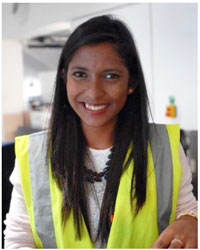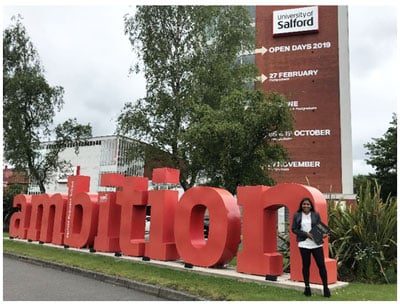The WISE Choice in Engineering: One Female Engineer's Journey Breaking Stereotypes
Happy International Women in Engineering Day! Follow the hashtag on social media, #INWED19, and enjoy our guest post below by Melissa Ahmed, managing director at Techwuman Ltd.
I started my career in engineering, unaware that less than 10% of UK engineers are women. This is a fact that really shocked me when I embarked upon my engineering career, and has set a pathway and drive inside me to become a role model for the next generation of female engineers in order to improve gender parity in the industry.
 Gender parity in the STEM (Science, Technology, Engineering and Mathematics) industries has been deliberated for more than 100 years. The Women’s Engineering Society (WES) was founded in 1919 by a group of women whose mission was to resist the pressure for men to reclaim their engineering jobs following World War I, and to promote engineering as a rewarding job for women.
Gender parity in the STEM (Science, Technology, Engineering and Mathematics) industries has been deliberated for more than 100 years. The Women’s Engineering Society (WES) was founded in 1919 by a group of women whose mission was to resist the pressure for men to reclaim their engineering jobs following World War I, and to promote engineering as a rewarding job for women.
As STEM industries evolve, the world we live in develops with the introduction of new medicines, inventions, technologies, and mechanisms, and there is more work and effort focused on gender parity within industry. There is a need within all industries for different genders and mindsets to interact together—creating better ideas and solving problems more efficiently using different points of view.
According to the website Female First, “Having women present at every stage of the design process is key to ensuring that both male and female perspectives are taken into account, allowing for diversity of thought and better products being produced.”
Choosing a career path starts early on in a person’s life, beginning with GCSE choices, onto A-Level choices, and then choice of degree. Currently you are expected to choose your GCSE options as early as age 15, which starts the ‘what job will I do in the future’ cog turning. This was the typical pathway that was portrayed to me as a child, but today there are many alternative career paths available. Apprenticeships, full-time jobs, part-time degrees, HNC’s, and foundation-degree courses are all on offer to suit all types of learning.
As the world advances, these decisions can be influenced earlier on in life, even as young as nine years old—during primary education. Teachers and STEM Ambassadors can show how fun and exciting a job within the industry can be, and the range of opportunities available within the STEM industry.
As found on the website Careers Advice for Parents, “Research in 2012 by the UK Commission for Employment and Skills (UKCES) found that the share of full-time learners at 16-17 years old who combine work with their learning has been declining steadily from 40% in the late 1990’s to around 20% in 2011. This indicates that young people in the UK are leaving education increasingly less experienced in the working world.”
And, according to Renishaw, a leading engineering and scientific technology company, “Employment surveys have found that a large number of employers rate previous job experience as critical for new recruits. It’s estimated that we need to be at least doubling the number of engineering apprenticeships and graduates each year just to keep up with demand.”
Ten years ago, I was a 15-year-old girl deciding upon the career I was going to venture into in the future. I was advised to choose my options carefully and make sure I really enjoyed those subjects. However, being at an age where I had a lack of life experience, it was difficult to decide without the experience in different roles and industries.
For me it was trial and error discovering what career I was interested in. Luckily, I had heaps of support from my parents who were able to find me a range of different work-experience placements (web design, chemical engineering, medicine, and pathology) which were fundamental in deciding what career I wanted to pursue.
I believe that influences in our lives guide us, give us purpose, and impact on our career choice. I travelled around the world from a very young age and have also valued such influences as my grandad being an engineer and my father having spent 25 years of his working life in the aviation industry. This created my passion for aviation, adventures, and fixing things. I wanted a job where I could apply my passion for problem solving, mathematics, and my creative flair and design. Really there was only one obvious solution looking back—engineering!
 I started my engineering career with a degree in Aeronautical Engineering, including an industrial placement year at Technocover, a mechanical engineering company who are specialists in the security industry. Thereafter, I successfully completed a Knowledge Transfer Partnership (KTP) with Technocover & the University of Salford, revolutionising the design process of security products. Whilst completing the KTP I also gained a Masters by Research (MSc) in Mechanical & Aeronautical Engineering, a CMI Level 5 Award in Management, Lean Six Sigma Yellow & Green Belt, and became an Incorporated Engineer affiliated with the Institute of Mechanical Engineers.
I started my engineering career with a degree in Aeronautical Engineering, including an industrial placement year at Technocover, a mechanical engineering company who are specialists in the security industry. Thereafter, I successfully completed a Knowledge Transfer Partnership (KTP) with Technocover & the University of Salford, revolutionising the design process of security products. Whilst completing the KTP I also gained a Masters by Research (MSc) in Mechanical & Aeronautical Engineering, a CMI Level 5 Award in Management, Lean Six Sigma Yellow & Green Belt, and became an Incorporated Engineer affiliated with the Institute of Mechanical Engineers.
There is a need to break the mould of a stereotypical engineer, to show how fun and rewarding a role in engineering can be. Engineering was, and still is, seen to be a male-dominated environment, with most people thinking of jobs such as plumbers, electricians, mechanics, etc. More work needs to be done to promote the variety in engineering and the number of engineering jobs available—with engineering skills readily transferable from one industry to another.

To achieve my goal of becoming a role model and inspiring the next generation of female engineers, I started my own engineering consultancy company, Techwuman Ltd, which specialises in design engineering. The company’s mission is to demonstrate that engineering is not just for men, and that if your dream is to become an engineer, follow it and reach for the stars!
We will be helping to inspire and guide the next generation into a career in a STEM role, starting from primary school all the way up to university. One of our company's aims is to promote more women into STEM industries.
Whilst the theory behind STEM subjects is important for pupils to understand, at primary level the easiest way to communicate concepts with students is often through practical applications—doing, making, touching, and playing.
This can be achieved by:
- holding focused assemblies
- practical activities on Engineering/STEM topics
- introducing role models within the STEM industries
If you would like to follow my progress, you can keep up to date by following the social media channels below and also connecting with me on Linkedin.


